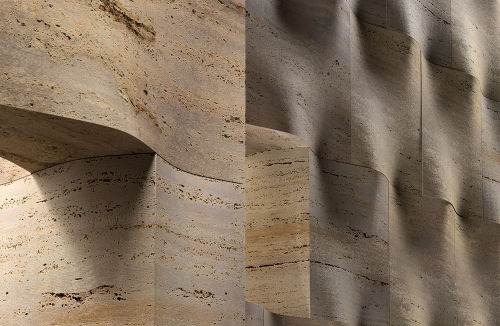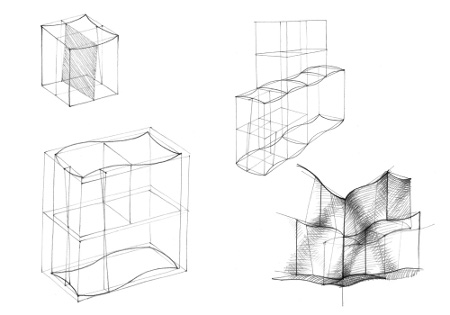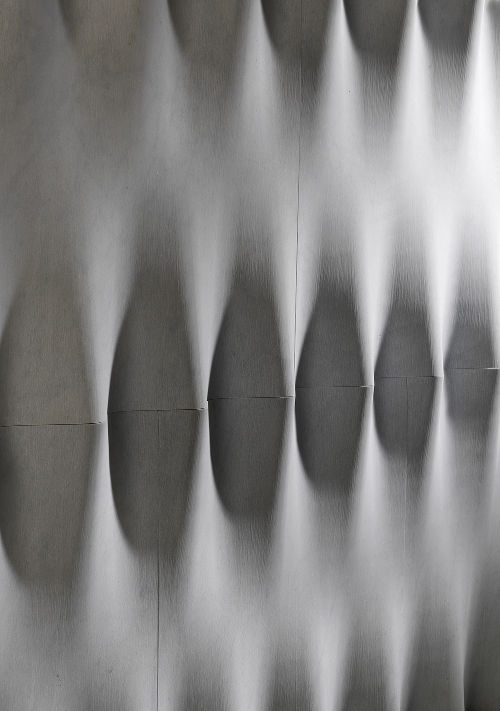18 Marzo 2013
English
Two experiences between three-dimensionality and thickness
Materia Litica

Raffello Galiotto per Lithos Design, Materia Litica.
[photogallery]materia_litica_album[/photogallery]
‘Materia litica’ explores the theme, which is currently undergoing a powerful re-evaluation and linguistic updating, of extremely thick, self-supporting single material structures. It is a composite wall, a collection of blocks shaped according to the curved folds of the materials. The pre-set variations in size (a typical block is 70 cm high, with the same thickness, by 180 cm long – which may change according to the design) are enough to make up a coordinated assemblage of elements for walls, corners and openings, or architraves. ‘Folding’, this time, the whole composition, raising parallel or perpendicular walls creates a closed form that isolates the space – both inside and out – giving life to the architecture.
The concave and convex surfaces, the undulating walls that form a system of enclosing environments and turning towards external spaces, virtually bend, with neither beginning nor end, and make the space palpitate.
The stone blocks of ‘Materia Litica’, considered individually in their stereotomic precision, but also placed together in short sequences, always create an intelligible formal identity that is the prelude to the construction of a wall.

Materia Litica, sketches for configuration of the stone blocks
‘Materia Litica’ is the formal reinterpretation, made possible today, of the theme of the ‘stone block’ and of its combinatory syntax. It is a natural material that has been separated and can therefore be recomposed according to a precise design. From blocks of stone, using profilers which are specially designed to create these complex, special-moulded pieces, elements are obtained that are perfectly shaped on all sides, with no waste. The upper profile of the stone coincides with the lower one and, mirror-like, perfectly fits its replica. The form of the single element is designed so that there is no abrasion or consumption of material on any side, but only a clear, sinuous cut. The soft, flexible nature of the profile derives from the constraint that every block must produce its opposite and in relation to the plane and continuity of the wall and corner elements. With no wasted stone we can reduce costs and production times, moreover the blocks can also be reused, just like the stones of ancient buildings.
Drappi di Pietra

Raffello Galiotto for Lithos Design, Drappi di Pietra, Tulle
The ‘Drappi di Pietra’ collection reveals the designer’s reference to the ‘textile’ metaphor of architectural coverings even more explicitly. Folds develop and tangle on the surface. They multiply and conceal, complicate and amplify the effect of stone.
It is not the first time that marble has been artificially ‘folded’. The plastic movement begins with the design, prefiguring an imagined reality and becomes a trajectory, an extensive reality that occupies an amount of space and time between a beginning and an end. Thus the dynamic of the line models the concept of form.
If we return to the several ‘Baroques’ of history, like the folds of clothes that invade the whole surface of canvasses and like the puffs and drapery that emerge from the confines of frames in painting, similarly in sculpture the folds in marble textiles ensure that the body of the structure is not ‘frozen’, but develops in the space, yearning for something ‘other’.
From his ‘textile’ design of the stone surfaces in ‘Le Pietre Incise’, Galiotto has taken many steps, achieving plasticity through fundamental innovations in both the creative and productive process, submitting carving and cutting to a ‘morphogenetic’ will.
The designer imbues the six models in ‘Drappi’ with a planar extension. The sinuous, palpitating, composable stone drapery deliberately evokes the tactile and objective perception of fabric. In the production phase each element is produced in the block of stone by the perfect curves of the sheet above, in a series of layers that are repeated with absolute precision and are only different from each other in the intrinsically decorative nature of the natural material.
They are the products of industrial design, but they develop and enrich the value and unique features of stone, aided by the perfect quality of their construction and their undoubted durability over time. The aesthetic and expressive aspect, made possible by the intelligent and creative use of latest generation machines, now shows its potential to distance the product from the technicisms of engineering alone and from the dictates of mass produced objects, opening up, with radical innovation, new areas of expansion in the world of stone and design in the global market.
The ‘ornamentation’ created by industrial means, through the complex elaboration of non-plane forms, is achieved with the support of stone itself, not independently or separate from it. In Lithos Design’s modern workshop, the designer of forms, the creator of ‘decoration’ and the ‘operator’ of machines meet in a single figure, combining worlds that were, until now, considered separate.
